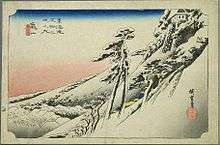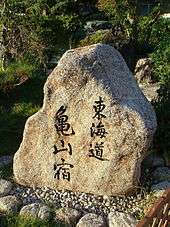Kameyama-juku
Kameyama-juku (亀山宿, Kameyama-juku) was the forty-sixth of the fifty-three stations (shukuba) of the Tōkaidō. It is located in former Ise Province in what is now part of the city of Kameyama, Mie Prefecture, Japan.

Kameyama-juku in the 1830s, as depicted by Hiroshige in the Hōeidō edition of The Fifty-three Stations of the Tōkaidō (1831–1834)
History
During the Edo period, Kameyama-juku served as both a post town and a castle town for Kameyama Castle. There are many buildings still remaining of both the post and castle town today.[1]

Kameyama-juku monument
The classic ukiyo-e print by Andō Hiroshige (Hōeidō edition) from 1831–1834 depicts travelers climbing a steep snow-covered hillside to the entrance of Kameyama Castle, which appears to be towering over the post station village.
Neighboring post towns
- Tōkaidō
- Shōno-juku - Kameyama-juku - Seki-juku
gollark: 🐪
gollark: ***mine***
gollark: I'd want it as a hatchling, personally.
gollark: Would it not make more sense to abandon it?
gollark: That does look good. I should try the same pairing.
References
- Kanko: Shiseki Archived 2007-12-14 at the Wayback Machine. City of Kameyama. Accessed December 18, 2007.
Further reading
| Wikimedia Commons has media related to Kameyama-juku. |
- Carey, Patrick. Rediscovering the Old Tokaido:In the Footsteps of Hiroshige. Global Books UK (2000). ISBN 1-901903-10-9
- Chiba, Reiko. Hiroshige's Tokaido in Prints and Poetry. Tuttle. (1982) ISBN 0-8048-0246-7
- Taganau, Jilly. The Tokaido Road: Travelling and Representation in Edo and Meiji Japan. RoutledgeCurzon (2004). ISBN 0-415-31091-1
This article is issued from Wikipedia. The text is licensed under Creative Commons - Attribution - Sharealike. Additional terms may apply for the media files.